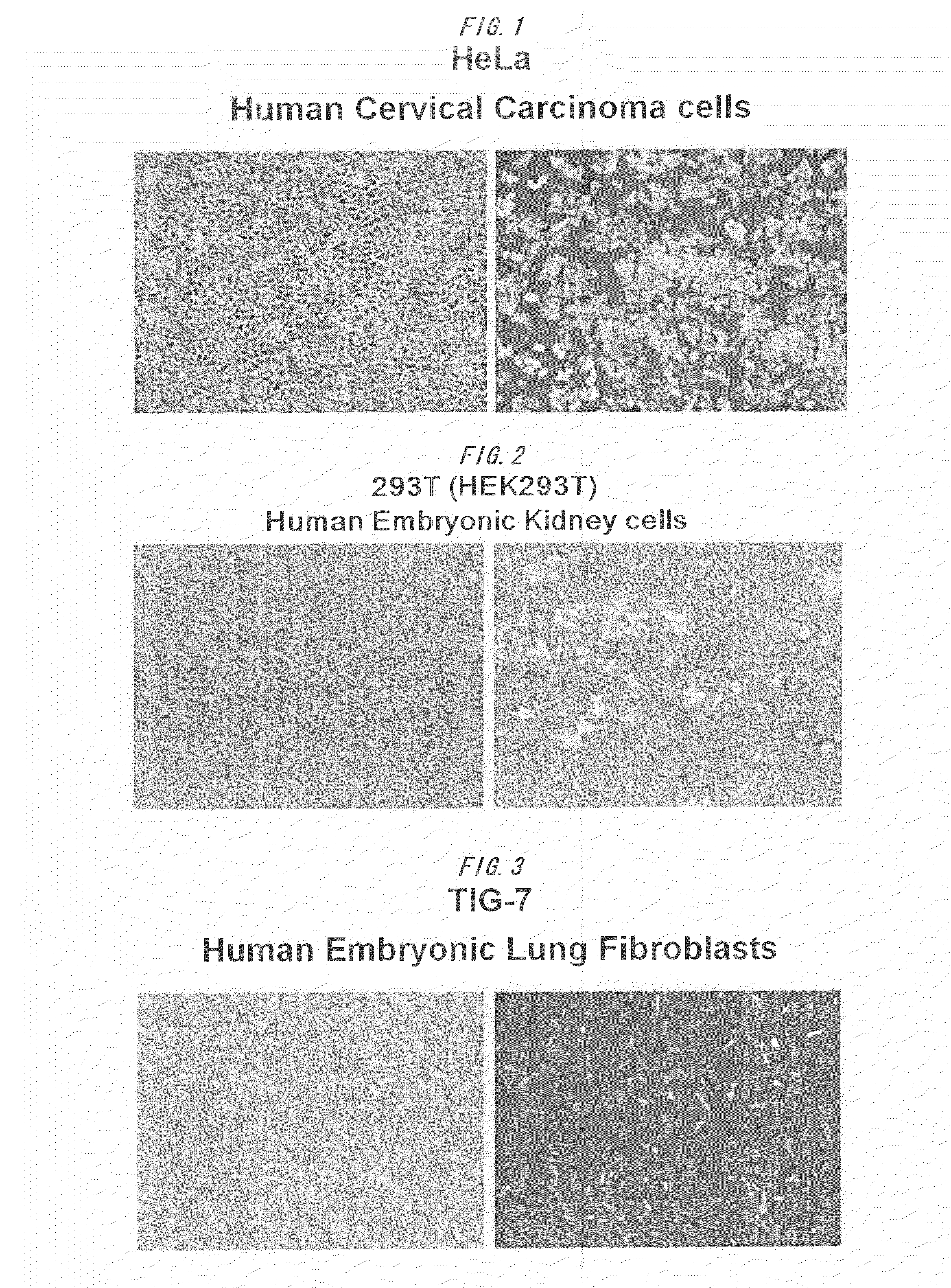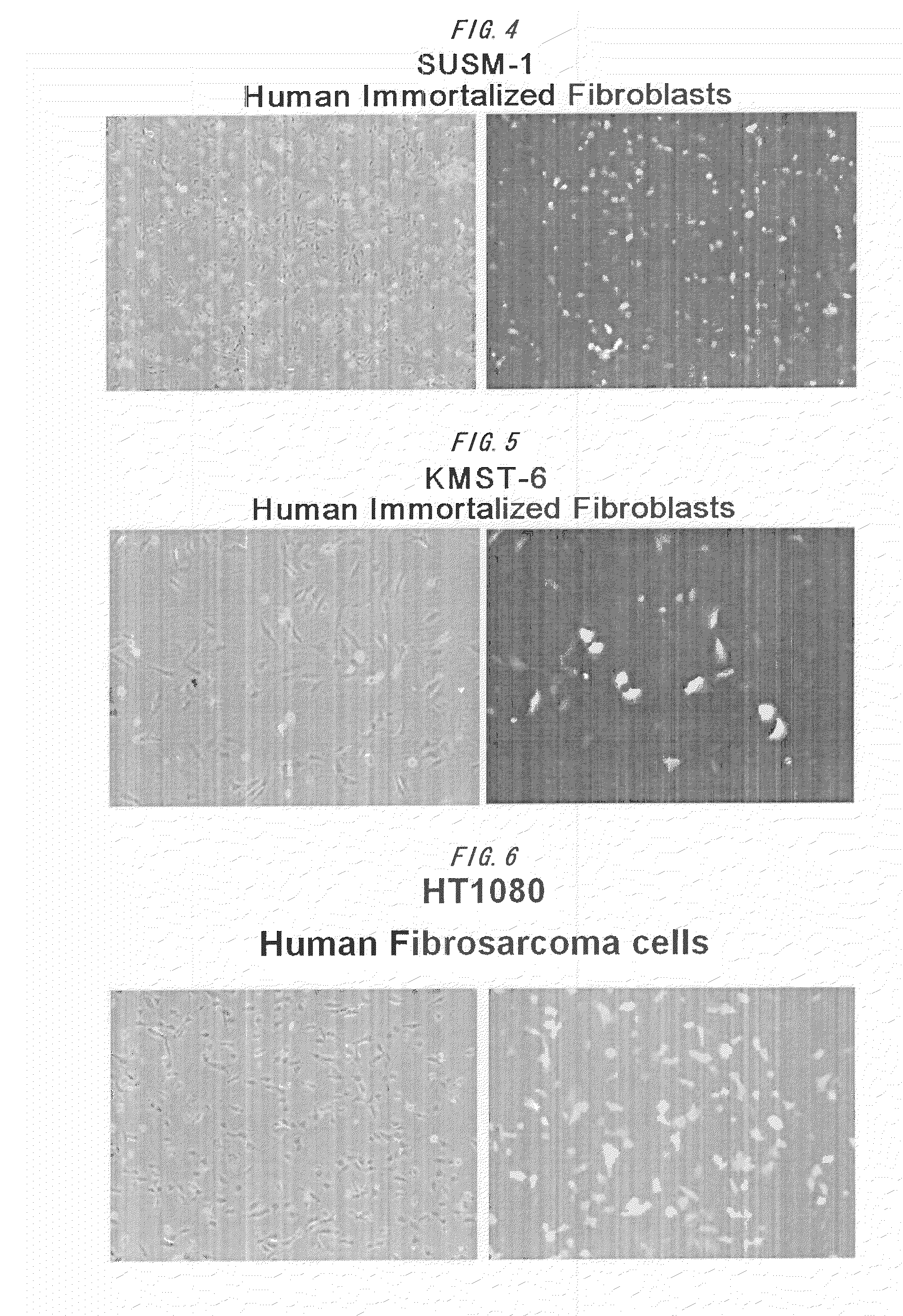Foreign gene transfer method by electroporation technique
a technology of electroporation and foreign gene, which is applied in the field of electroporation technique transfer of extraneous genes, can solve the problems of affecting the viability of cells, and reducing the gene transferring rate of electroporation technique, so as to improve the viability and gene transferring rate, the effect of reducing the running cost and high viability
- Summary
- Abstract
- Description
- Claims
- Application Information
AI Technical Summary
Benefits of technology
Problems solved by technology
Method used
Image
Examples
example 1
Effects of the First Electric Pulse and the Second Electric Pulse
(1) Preparation of Cells
[0115]A medium was removed from a culture vessel in which HeLa Cells (human cervical cancer cell line: adherent cells) were cultured. The cells were then washed two or more times with a 0.02% EDTA-PBS solution for eliminating the influence of serum contained in the medium. The cells in an adherent state were then separated by trypsin treatment.
[0116]After confirming the separation of the cells, trypsin was removed by adding the same volume of an electroporation buffer (ES medium as a serum / antibiotic-free medium (NISSUI PHARMACEUTICAL CO., LTD.)) as that of the enzyme liquid used for the trypsin treatment and centrifuging the mixture (˜1,000 rpm, 5 min).
[0117]The supernatant was then discarded. The separated cells were dispersed in the electroporation buffer, and 50 μL of the dispersion was sampled to measure the number of the cells with a hemocytometer. Centrifugation (˜1,000 rpm, 5 min) was pe...
example 2
Examination of Voltage of the First Electric Pulse (1)
[0130]As shown in Tables 2, the first electric pulse was applied by varying its voltage. Other conditions for electroporation were same to Example 1 (samples 2-11).
[0131]Note that a sample, which was not subjected to electric pulse treatment after put into the cuvette, was used as a control (sample 1).
[0132]And the viability and the gene transferring rate were calculated in the same manner as in Example 1. The result is shown in Tables 2.
[0133]The result showed that both the viability and the gene transferring rate were as high as 50% or more, when voltage of the first electric pulse was adjusted so as to be controlled in the range of electric field strength=500-875 V / cm and total calorie strength=1.39-4.37 J / 100 μL. Especially in the case of electric field strength=500-750 V / cm and total calorie strength=1.39-3.21 J / 100 μL, the viability and the gene transferring rate were as high as 80% or more.
TABLE 2-AFirst electric pulseDNAE...
example 3
Examination of Voltage of the Second Electric Pulse (1)
[0134]As shown in Tables 3, the second electric pulse was applied by varying its voltage. Other conditions for electroporation were same to Example 1 (samples 13-20).
[0135]Note that a sample, which was not subjected to electric pulse treatment after put into the cuvette, was used as a control (sample 12).
[0136]And the viability and the gene transferring rate were calculated in the same manner as in Example 1. The result is shown in Tables 3.
[0137]The result showed that the second electric pulse applied under a suitable condition can elevate largely the viability.
[0138]Specifically, when voltage of the second electric pulse was adjusted so as to be controlled in the range of electric field strength=50-250 V / cm and calorie strength per pulse=0.13-3.57 J / 100 μL, both the viability and the gene transferring rate were as high as 50% or more. Especially in the case of electric field strength=75-125 V / cm and calorie strength per pulse=...
PUM
| Property | Measurement | Unit |
|---|---|---|
| electric field strength | aaaaa | aaaaa |
| electric field strength | aaaaa | aaaaa |
| electric field strength | aaaaa | aaaaa |
Abstract
Description
Claims
Application Information
 Login to View More
Login to View More - R&D
- Intellectual Property
- Life Sciences
- Materials
- Tech Scout
- Unparalleled Data Quality
- Higher Quality Content
- 60% Fewer Hallucinations
Browse by: Latest US Patents, China's latest patents, Technical Efficacy Thesaurus, Application Domain, Technology Topic, Popular Technical Reports.
© 2025 PatSnap. All rights reserved.Legal|Privacy policy|Modern Slavery Act Transparency Statement|Sitemap|About US| Contact US: help@patsnap.com



